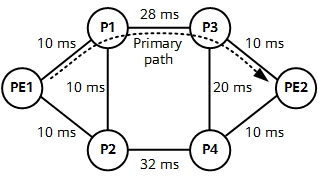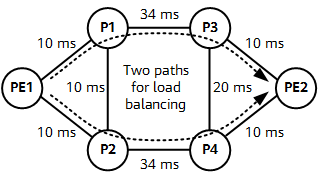SRv6 Flex-Algo Delay Tolerance
For the delay-based Flex-Algo algorithm, the difference in delay between links is basically different and may be very small. However, according to the existing SPF algorithm, only one optimal path can be generated even if the difference is very small, and load balancing cannot be implemented within a certain delay tolerance range. Consequently, link resources on a network cannot be fully utilized.
To solve this problem to the greatest extent, the delay on the link needs to be normalized and then is advertised in the IS-IS LSP. The following concepts are involved in the normalization:
- Measured delay (dm): interface delay detected using TWAMP.
- Normalized interval (interval): It is configurable.
- Normalized offset (offset): It is configurable and must be less than the interval.
- Normalized delay (nm): last advertised delay.
The following formula is used to calculate the normalized value:
- a = dm/interval (rounded down)
- b = a x interval + offset
- nm: If dm is less than or equal to b, nm is equal to b. If dm is greater than b, nm is equal to b + interval.
As shown in Figure 1, if the TWAMP measured delay between P1 and P3 is 28 ms and that between P2 and P4 is 32 ms, only one primary path can forward traffic when the SRv6 Flex-Algo calculates paths based on the delay.
On P1 and P2, after the normalized interval and offset are set to 10 ms and 4 ms, respectively, the Flex-Algo delay is normalized.
- a = 28/10 = 2 (2.8, rounded down to 2)
- b = 2 x 10 + 4 = 24
- Because the measured delay value 28 is greater than 24, the normalized delay value is b + interval = 24 + 10 = 34 ms.
- a = 32/10 = 3 (3.2, rounded down to 3)
- b = 3 x 10 + 4 = 34
- Because the measured delay value 32 is less than 34, the normalized delay value is b = 34 ms.
As shown in Figure 2, the normalized delay values of the P1-P3 and P2-P4 links are the same. When the SRv6 Flex-Algo calculates paths based on delay, both paths can work in load balancing mode.

